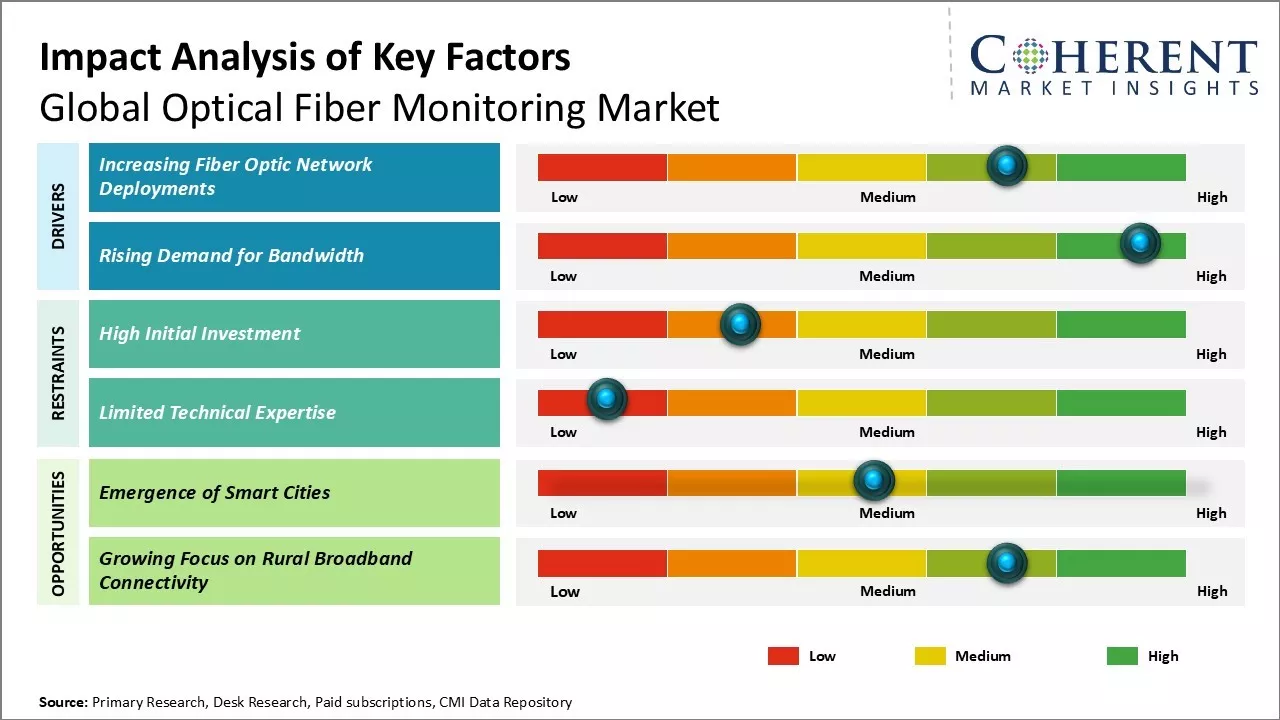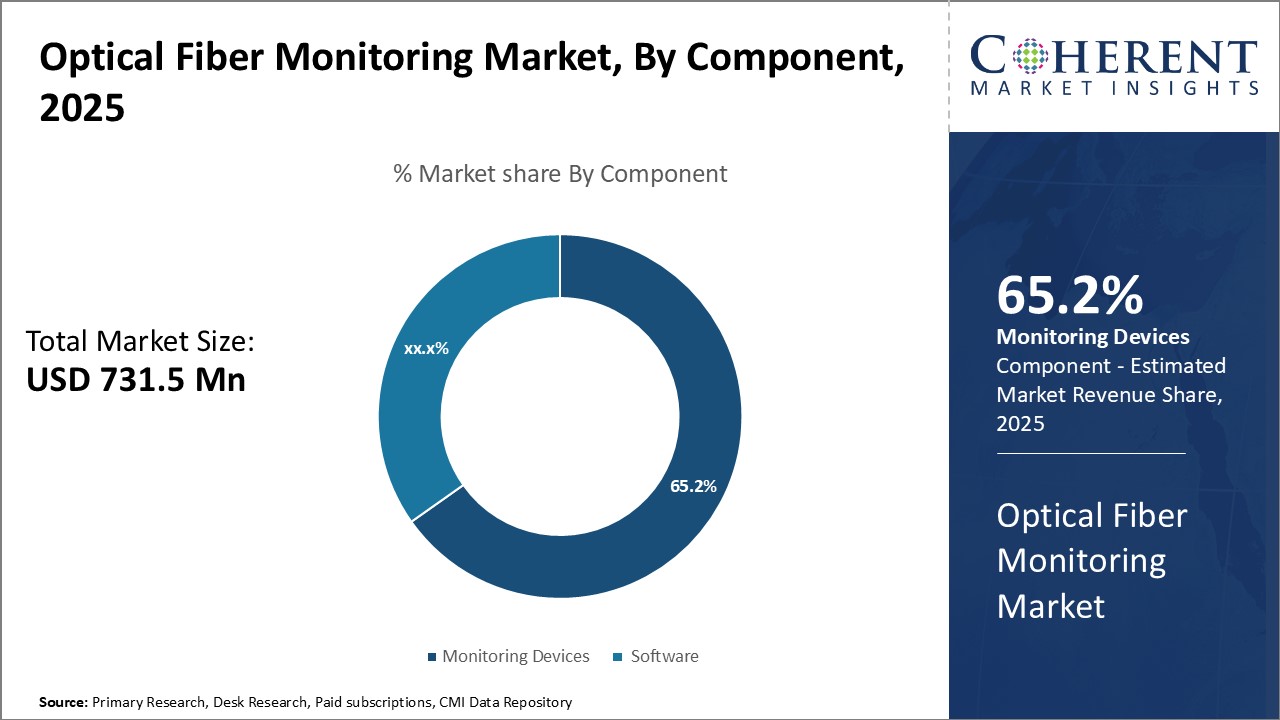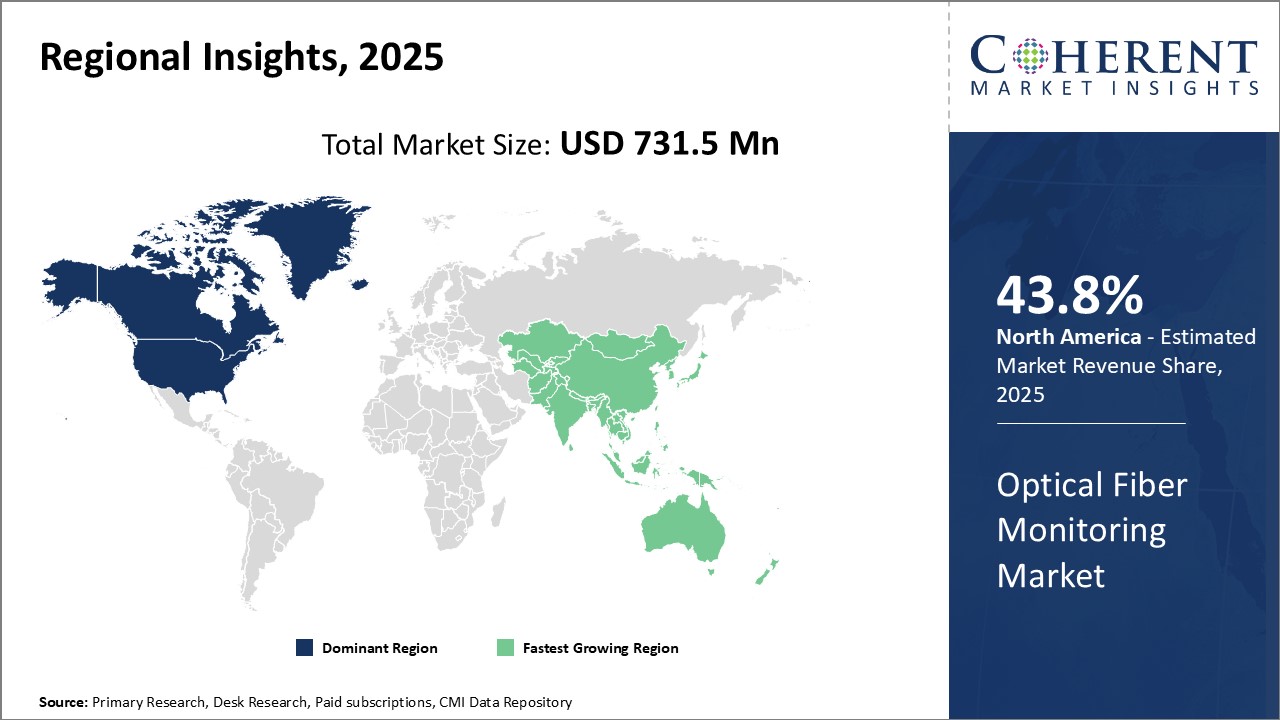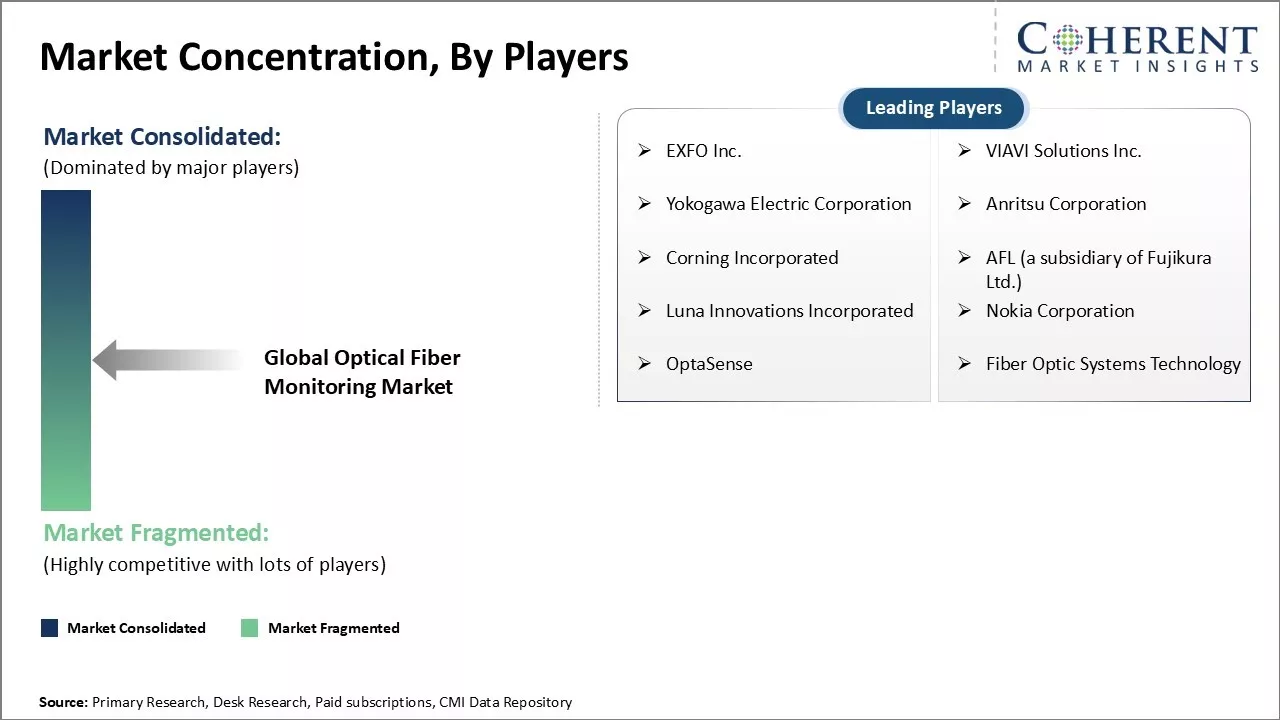Optical Fiber Monitoring Market Size and Trends
Global optical fiber monitoring market is estimated to be valued at USD 731.5 Mn in 2025 and is expected to reach USD 1,982.9 Mn by 2032, exhibiting a compound annual growth rate (CAGR) of 15.3% from 2025 to 2032.

Discover market dynamics shaping the industry: Download Free Sample
The optical fiber monitoring market is expected to witness significant growth driven by growing need for optimization and efficiency in fiber optic networks. Furthermore, with increasing deployment of fiber to meet the demands of 5G rollout and broadband infrastructure development in various countries, especially in developing nations, the need for effective monitoring systems is also witnessing a rise. Various technological advancements focused on providing greater visibility and insights are further supporting the market growth. Key players EXFO Inc., VIAVI Solutions Inc., Yokogawa Electric Corporation, and Anritsu Corporation are investing in research and development to come up with innovative solutions such as distributed sensing technology, which is also expected to provide opportunities for revenue generation in the market.

Discover high revenue pocket segments and roadmap to it: Download Free Sample
Insights by Component - Reliability and Precision Drive the Adoption of Monitoring Devices
In terms of component, the monitoring devices segment is estimated to hold the highest market share of 65.2% in 2025, owing to their criticality in delivering reliable optical fiber network performance measurement. Monitoring devices are installed at various nodes along the fiber network to continuously supervise the operational parameters like transmission loss, power levels, and signal quality. They help detect even minor faults and deteriorations promptly to prevent major network failures. Network operators heavily rely on monitoring devices' precise readings to proactively schedule maintenance and address issues before customer experience is compromised. Their self-powered nature requiring no external power source further increases their usability for remote locations with limited infrastructure.
Insights by Technology - Widespread Adoption Drives Growth in Distributed Fiber Optic Sensing
In terms of technology, the distributed fiber optic sensing (DFOS) segment is estimated to hold the highest market share of 41.8% in 2025 owing to its widespread deployment across networks. DFOS monitors fiber equally over its entire length using optical time domain reflectometry instead of discrete sensing points. This allows much higher spatial resolution and denser monitoring coverage compared to traditional techniques. As a result, it can detect minute disturbances or intrusions much earlier and pinpoint their locations precisely.
Insights by Application: Strategic Imperatives Fuel Telecommunications Adoption
In the terms of application, the telecommunications segment is estimated to hold the highest market share of 37.3% in 2025. Telecom operators require uninterrupted services that increasing dependence on digital networks has imposed. Optical fiber is the backbone technology upon which billions of connectivity experiences depend daily. Even minor disturbances can result in large-scale outages and loss of customer trust. Thus, operators prioritize robust fiber monitoring for rapid fault management. Moreover, fiber monitoring emerges as a strategic necessity for operators to sustain quality and retain subscriber loyalty in fiercely competitive telecom markets.
Regional Insights

Need a Different Region or Segment? Download Free Sample
Regional Analysis: Global Optical Fiber Monitoring Market
Dominating Region: North America
North America is expected to account for the greatest revenue share of 43.8% in 2025. North America’s dominance in the optical fiber monitoring market can be attributed to robust network infrastructure and early technology adoption.
Fastest-Growing Region: Asia Pacific
The Asia Pacific exhibits the fastest growth, fueled by the rapidly developing telecom industry across emerging economies such as China, India, Indonesia, and Vietnam.
Optical Fiber Monitoring Market Outlook for Key Countries
U.S.: The optical fiber monitoring market in the U.S. is characterized by the availability of innovative products and strong focus on network optimization from major operators.
China: The optical fiber monitoring market in China is driven by the government's efforts to enhance connectivity. Leading domestic players are also contributing through cost-effective solutions.
Japan: The optical fiber monitoring market in Japan continues to lead in terms of technology upgrades, with key players launching advanced automated systems.
India: The optical fiber monitoring market in India is witnessing increased spend on network infrastructure under national broadband projects.
Market Concentration and Competitive Landscape

Get actionable strategies to beat competition: Download Free Sample
Top Strategies Followed by Global Optical Fiber Monitoring Market Players
- R&D Investment: Leading companies in the global optical fiber monitoring market focus extensively on research and development to innovate high-performance products. They invest heavily in developing advanced technologies such as distributed acoustic sensing, Optical Time-Domain Reflectometer (OTDR) and optical time domain reflectometer devices. This allows them to integrate the latest capabilities into their solutions and maintain an edge over competition. For example, major players like Fujikura and AFL have established R&D centers globally to conceptualize novel optical fiber monitoring systems.
- Strategic Partnerships: Established players also pursue strategic alliances with major telecom operators and OEMs to strengthen their position in the industry. Such collaborations help gain customer insights, complement mutual technologies, and expand respective market shares. For instance, In December 2023 Nokia partnered with Deutsche Telekom to pilot its next-gen distributed acoustic sensing technology for telecom fiber network monitoring across Europe.
- Global Expansion: Furthermore, top companies make huge investments in broadening their international footprint through new facilities, partnerships and acquisitions. This enables them to scale operations and address the growing need for optical fiber monitoring across diverse geographies. For example, In October 2023 National Instruments acquired OptoTest to augment its presence in Asia Pacific while QinetiQ partnered with Technilum to penetrate the Latin American market.
Emerging Startups in the Global Optical Fiber Monitoring Market
Innovative Technologies: Several young companies are developing cutting-edge solutions to disrupt the industry. Photonics101 has created an AI-based predictive maintenance system that monitors fiber plant health using hyperspectral imaging. Startup SparkOptics utilizes onboard optical component testing and advanced deep learning algorithms to provide real-time diagnostics. Such innovative technologies could transform the way networks are monitored and help operators move from reactive to proactive maintenance approaches.
Sustainable Solutions: Startups like FiberSense focus on more sustainable operations through eco-friendly product designs. It reuses 15% of components from decommissioned cables to manufacture new monitoring hardware. Chromacity has pioneered a recycling program for discarded fiber optic cables, extracting over 99% of materials like copper and glass for reuse. Their contributions help ease industry reliance on raw materials and reduce electronic waste generation.
Niche Markets: Some startups occupy underserved market niches. For example, Senstar specializes in monitoring critical infrastructure using distributed fiber sensor systems along pipelines, railways and borders. AquaFi monitors aquaculture farms and employs optical sensors to enhance fish welfare.
Optical Fiber Monitoring Industry News
In January 2024, Nokia and Zayo Group achieved a new North American record by transmitting 800Gb/s over an impressive distance of 1,040 kilometers on Zayo's live network. This milestone showcases Nokia's advanced PSE-6s (Photonic Service Engine) coherent optics technology, which enhanced the reach and performance of high-capacity data transmission on a live network
In July 2023, OFS (a subsidiary of Furukawa Electric Co., Ltd.) and Heraeus Comvance announced that Heraeus would acquire OFS's manufacturing draw towers and facility located in Denmark. This strategic acquisition is aimed at enhancing Heraeus's capabilities in producing telecommunication fibers to better serve the EMEA (Europe, Middle East, and Africa) market.
In May 2023, In May 2023, CommScope launched its new HomeVantage Fiber Gateways and Optical Network Units (ONUs) at the ANGA COM trade show in Germany. This product launch is part of CommScope's strategy to enhance broadband connectivity solutions for residential and business customers.
Key Takeaways from Analyst
- Global optical fiber monitoring market is expected to witness significant growth driven by the rising demand for high bandwidth connections and increased network complexities. The ever-growing mobile data traffic and increasing deployment of 5G networks worldwide will propel the need to continuously monitor optical fibers. Moreover, the surge in Fiber-To-The-Home connections is creating opportunities for market participants to offer suitable fiber monitoring solutions. North America currently dominates the market owing to heavy investments in communication infrastructure upgrade. However, Asia Pacific is likely to become the fastest-growing region in the coming years on account of rapid digitalization in countries like China and India. On the contrary, high initial investment and maintenance costs associated with fiber monitoring equipment can negatively impact the market's growth. Lack of awareness regarding the benefits of real-time fiber monitoring solutions among telecom operators in developing nations may also restrain the market.
Market Report Scope
Optical Fiber Monitoring Market Report Coverage
| Report Coverage | Details | ||
|---|---|---|---|
| Base Year: | 2024 | Market Size in 2025: | USD 731.5 Mn |
| Historical Data for: | 2020 To 2024 | Forecast Period: | 2025 To 2032 |
| Forecast Period 2025 to 2032 CAGR: | 15.3% | 2032 Value Projection: | USD 1,982.9 Mn |
| Geographies covered: |
|
||
| Segments covered: |
|
||
| Companies covered: |
EXFO Inc., VIAVI Solutions Inc., Yokogawa Electric Corporation, Anritsu Corporation, Corning Incorporated, AFL (a subsidiary of Fujikura Ltd.), Luna Innovations Incorporated, Nokia Corporation, OptaSense, and Fiber Optic Systems Technology |
||
| Growth Drivers: |
|
||
| Restraints & Challenges: |
|
||
Uncover macros and micros vetted on 75+ parameters: Get instant access to report
Market Dynamics
Market Driver - Increasing Fiber Optic Network Deployments
As fiber optic networks are becoming the backbone of communication systems globally, there has been substantial investments in laying new fiber infrastructure as well as upgrading the existing networks. This growth in fiber deployments has been driven by both telecom operators as well as large internet companies. For example, according to statistics released by the International Telecommunication Union, the total fiber footprint globally grew from 420 million fiber kilometers in 2018 to 480 million fiber kilometers in 2020, an increase of around 15%. This massive increase in fiber deployment is driving the need for better monitoring and management solutions.
Market Challenge - High Initial Investment
One of the key challenges in the global optical fiber monitoring market is the high initial investment required for the deployment of optical fiber monitoring solutions. Setting up a network of distributed temperature and strain sensors along an optical fiber cable requires substantial capital expenditure. For instance, Sub-Saharan African countries invested only 0.6% of their GDP in the telecom infrastructure in 2020 compared to the global average of 1.6%, as per data compiled by the United Nations Conference on Trade and Development.
Market opportunity - Emergence of Smart Cities
The growing focus on the development of smart cities across the world presents significant opportunities for the optical fiber monitoring market. Smart city initiatives involve deployment of digital technologies and sensors to optimize infrastructure utilization and service delivery. Optical fiber networks lay the backbone for smart cities as they enable deployment of various sensing applications for monitoring utilities. For instance, a fiber monitoring system was implemented across Massachusetts to oversee broadband deployments facilitating smart community projects. It helped deploy over 2,300 km of fiber reaching over 100,000 homes in 2025.
Market Segmentation
- Component Insights (Revenue, USD, 2020 - 2032)
-
- Monitoring Devices
- Software & Services
- Technology Insights (Revenue, USD, 2020 - 2032)
-
- Distributed Fiber Optic Sensing (DFOS)
- Active Fiber Monitoring
- Passive Fiber Monitoring
- Application Insights (Revenue, USD, 2020 - 2032)
-
- Telecommunications
- Energy & Utilities
- Healthcare
- Transportation
- Military & Defense
- Regional Insights (Revenue, USD, 2020 - 2032)
- North America
- U.S.
- Canada
- Latin America
- Brazil
- Argentina
- Mexico
- Rest of Latin America
- Europe
- Germany
- U.K.
- Spain
- France
- Italy
- Russia
- Rest of Europe
- Asia Pacific
- China
- India
- Japan
- Australia
- South Korea
- ASEAN
- Rest of Asia Pacific
- Middle East
- GCC Countries
- Israel
- Rest of Middle East
- Africa
- South Africa
- North Africa
- Central Africa
- North America
- Key Players Insights
- EXFO Inc.
- VIAVI Solutions Inc.
- Yokogawa Electric Corporation
- Anritsu Corporation
- Corning Incorporated
- AFL (a subsidiary of Fujikura Ltd.)
- Luna Innovations Incorporated
- Nokia Corporation
- OptaSense
- Fiber Optic Systems Technology
Share
Share
About Author
Ankur Rai is a Research Consultant with over 5 years of experience in handling consulting and syndicated reports across diverse sectors. He manages consulting and market research projects centered on go-to-market strategy, opportunity analysis, competitive landscape, and market size estimation and forecasting. He also advises clients on identifying and targeting absolute opportunities to penetrate untapped markets.
Missing comfort of reading report in your local language? Find your preferred language :
Transform your Strategy with Exclusive Trending Reports :
Frequently Asked Questions
EXISTING CLIENTELE
Joining thousands of companies around the world committed to making the Excellent Business Solutions.
View All Our Clients
